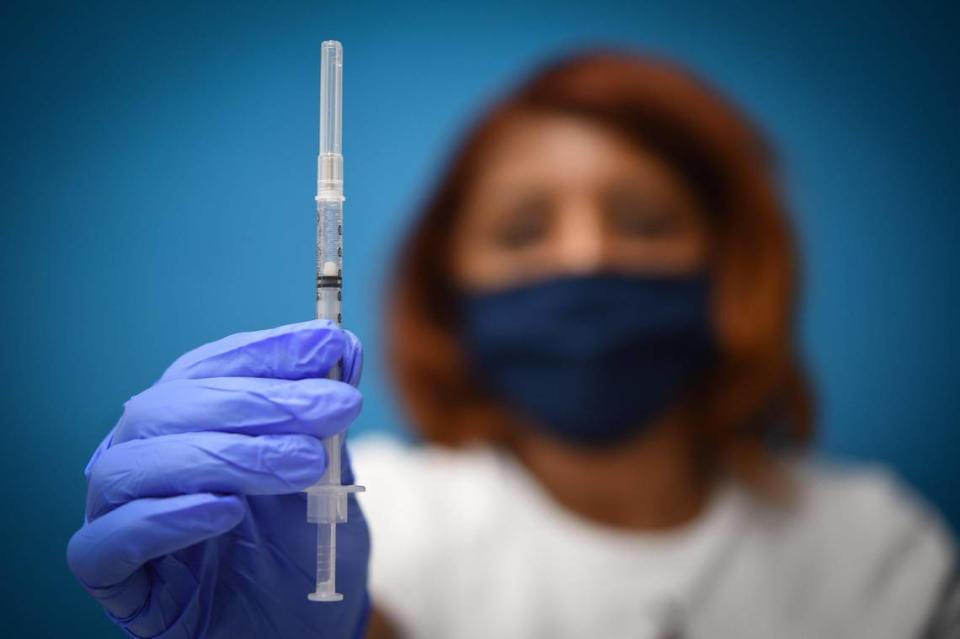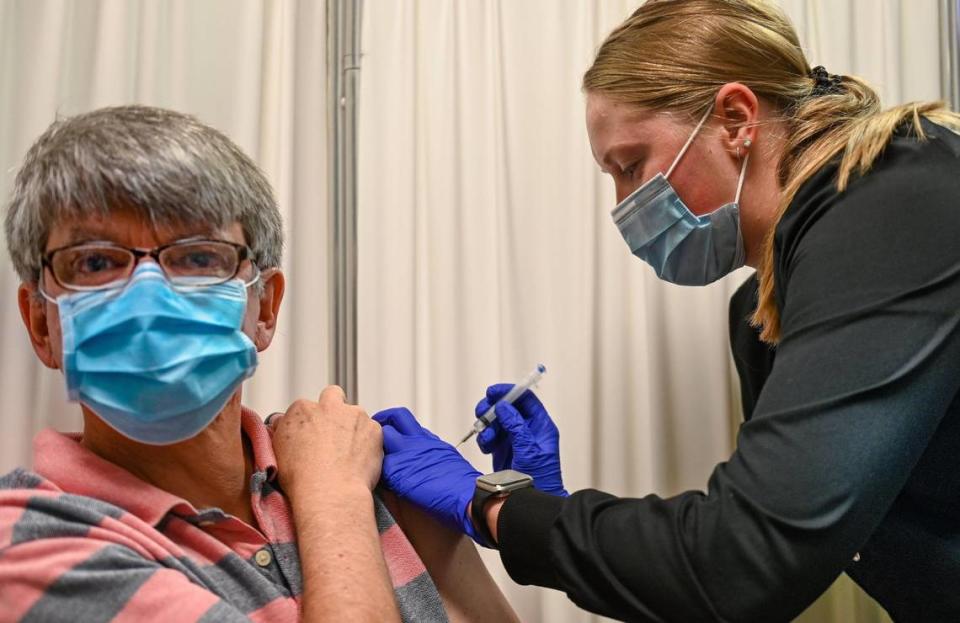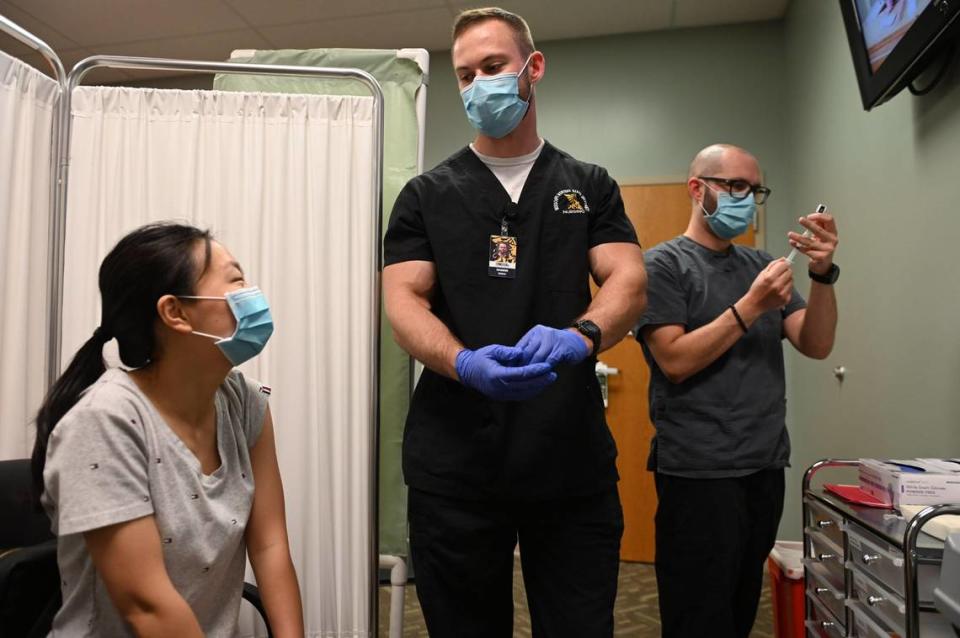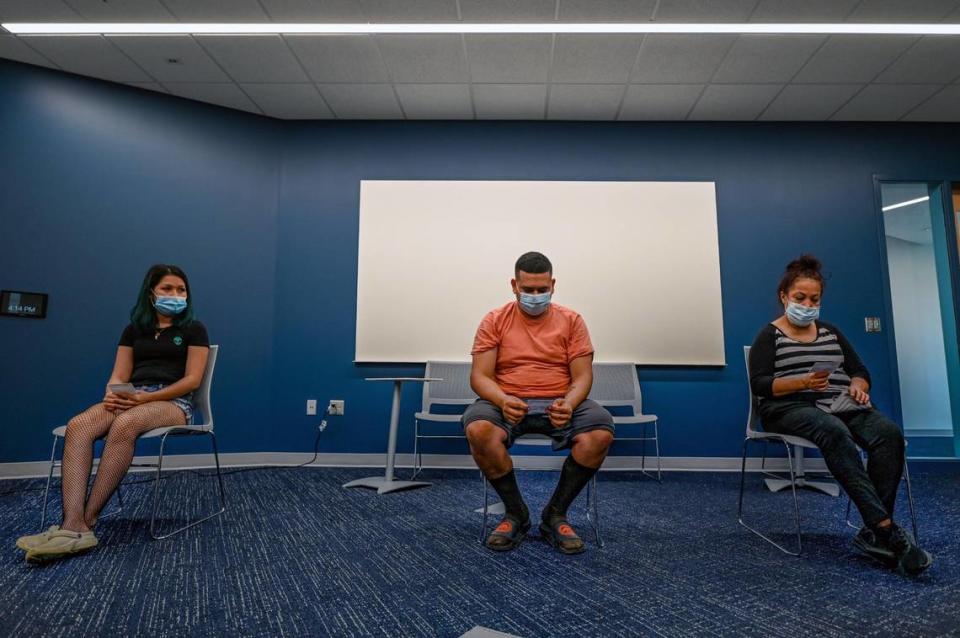Kansas, Missouri could take months to reach key vaccination threshold as delta surges
Vaccinations have risen in Kansas and Missouri as more residents line up for shots, amid fears they could become the delta variant’s latest victim or in hopes of snagging a cash prize.
But even the accelerated pace of inoculations in recent days comes with a sobering reality. It’s highly unlikely that either state will be able to vaccinate itself out of the current wave of infections. Given delta’s contagiousness, the dream of ever achieving herd immunity remains far away, if not out of reach.
An analysis of Centers for Disease Control and Prevention vaccination data by The Star suggests it will still take months — even at the more recent, accelerated pace of shots — to get at least one dose to 70% of the population in both states. Kansas could take 128 days and Missouri 141 days to reach what has previously been thought to be a possible herd immunity threshold, based on the average daily number of first doses in late July.
According to a separate analysis from American Public Media Research Lab, Kansas won’t achieve a 70% vaccination rate until November and Missouri won’t reach the same level until February. The APM Research Lab figures are based on rates of vaccination in late July, when Kansas and Missouri were two of the top states for shots.
Over two weeks in mid-to-late July, Kansas delivered first shots to 2.7% of its population and Missouri vaccinated 1.9%, APM Research Lab found.
About 45% of Kansas residents and 42% in Missouri are fully vaccinated, according to the CDC. A somewhat greater percentage has had at least one shot: 54% in Kansas and 49% in Missouri.

To be sure, the quickening pace of vaccinations is a welcome sign in the heart of one of the nation’s worst COVID-19 outbreaks at the moment. The spike in cases is testing hospitals and leading to new mask mandates. Every additional full vaccination is one more person almost completely protected from the risk of hospitalization and death from the virus.
And the projections hold a silver lining: If the rates can be improved a bit more, both states may be able to protect a supermajority of their population from the danger of severe illness and death ahead of a possible winter surge.
Pushing the rates even higher might prove impossible, however. It’s already taken the threat posed by the variant and an extraordinary effort of outreach and persuasion to drive the recent uptick in shots.
“It’s kind of a double-edged sword and a sad state where you have something like delta coming around, but it’s been pushing a lot of people to really reconsider getting that vaccine,” said Chad Johanning, a Lawrence doctor and chair of the board of the Kansas Academy of Family Physicians.
More delta, more vaccinations
The rise in vaccinations across Kansas and Missouri has occurred amid a new wave of cases, driven by delta. It took hold in June and swept across much of Missouri and sections of Kansas in July. In the Kansas City region alone, the average number of new cases each day was as low as 60 at the end of May. It’s now more than 500, matching a volume not seen since early February.
Hospitalizations are also up and pushing some facilities to their limits. In Springfield, hospitals continue to treat hundreds of patients and have relied on the aid of an ambulance “strike team” to help transport patients.
Kansas City area hospitals have declined patient transfers. The number of COVID-19 patients continues to rise sharply, from an average of 39 new admissions a day at the start of June to 140 earlier this week.
Many of the oldest and most vulnerable in both states were vaccinated early this year, which has helped blunt delta’s impact on those groups. The result is that many of the latest victims are instead younger and unvaccinated.
It’s a turnaround from early in the pandemic, when more of those succumbing to the virus were older.

“Importantly, we’re seeing the most significant increases in states with the highest case rates,” Jeff Zients, the White House COVID-19, said Thursday of new vaccinations.
Kansas was administering an average of 3,867 doses a day and Missouri 13,554 doses a day as of July 30, according to CDC data. It’s a substantial increase from early July, when averages hovered around 1,600 in Kansas and 7,400 in Missouri.
Both states remain well below their March and April highs, when Kansas averaged more than 15,000 first shots a day and Missouri more than 50,000.
Missouri has launched an extensive incentives program featuring rounds of drawings with cash prizes for adults or scholarships for children and students. Nine hundred people will eventually win prizes of $10,000.
The effectiveness of large incentive programs remains unclear. Boston University School of Medicine researchers found that the million-dollar lottery in Ohio, where vaccinations initially soared after the program began, ultimately “was not associated with an increase in COVD-19 vaccinations.”
In Maine, few people claimed the rewards but officials said they were happy to see young people had participated in the program.
Lisa Cox, a spokeswoman for the Missouri Department of Health and Senior Services, attributed the state’s rising vaccinations to both the incentive program and delta’s aggressive nature.
“We certainly hope to see the trend in more Missourians seeking vaccination continue as access to vaccination opportunities continue at the community level,” Cox said in an email.
Fewer obstacles
The region is swamped with vaccines.
Shots, with no appointments needed, are widely available at grocery stores and pharmacies. The Kansas Department of Health and Environment said Thursday that local health departments will hold vaccine clinics at schools as students prepare to head back to class.
Vaccinations are also being made available at an increasing number of community events, such as fairs, festivals and sporting events.
“I have personally suspected that a lot of this modest increase that we’re seeing may be those who are — I call them the apathetic,” said Dennis Kriesel, director of the Kansas Association of Local Health Departments.
By that, Kriesel means those 25-to-40 years old who are now seeking out vaccinations as they watch those in their age group get sick and become hospitalized.
“I’ve hoped that most of it’s been apathy because the apathy’s relatively easy to solve,” Kriesel said. “There’s all these different flavors of hesitancy and I think the apathetic get lumped into that. But that’s just reducing the barriers to make it as easy as possible to convince them to take it.”
Still, easy access doesn’t guarantee interest. No one showed up to get a shot at the St. Charles County fair near St. Louis last week, even though all three approved vaccines were available.

Brett Bricker, a specialist in communications studies at the University of Kansas who has researched vaccine hesitancy, said the remaining unvaccinated population has many different beliefs and obstacles to getting a shot. Some have had bad experiences with the medical system while others believe in conspiracy theories, for example.
“The list goes on and on and on,” Bricker said. “And now we’re through that easy set of people, I think it is inevitably going to be slow to figure out the particular needs of this final group of people.”
Is herd immunity possible?
Kansas and Missouri have fully vaccinated less than half of their residents, far less than the rates health experts have previously said are needed to achieve herd immunity.
“We don’t really know yet what herd immunity looks like, we don’t know what that is,” said Lori Tremmel Freeman, CEO of the National Association of County and City Health Officials. “The more people are vaccinated the sooner we can do it.”
But even the goal of herd immunity has been called into question recently.

Some experts now estimate that because of delta, 90% or more may need vaccination to fully block the virus from circulating. The population of vaccine resistant individuals, combined with those who can’t get a shot because they’re immunosuppressed or other reasons, make it difficult to envision a future where either state — or the United States as a whole — achieves this rate.
If herd immunity is out of reach, the focus of vaccinations will shift further away from the hope of fully stamping out the virus and toward protecting as many people as possible, blunting the impact of future waves, and reducing the opportunities for the virus to mutate and produce more powerful variants.
The surge of cases last winter strained hospitals across the region. It also came at the very beginning of the vaccine rollout. A new surge this coming winter could be limited by vaccination rates, especially if 70% of residents have gotten shots.
For Johanning, the Lawrence physician, navigating a future where COVID is still around means paying more attention to what activities may lead to an infection. Wearing an N-95 mask at an outdoor concert is not the future, but masking up in a crowded room might be.
“I’d like to hope that this is just a speed bump, not just a foretelling of what’s to come in future variants,” he said.
The Star’s Katie Bernard and Jeanne Kuang contributed reporting

